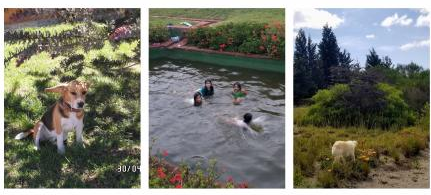
The Accidental Andean Land Project
Back in 2010, my husband David and I decided to move from the capital of Ecuador to the countryside. Our goal was to live a healthy, peaceful life, away from the noise and pollution of Quito. Once we found a plot, our initial plans were to create a simple garden, but gradually we became involved in something far greater than ourselves: a land regeneration project! In Part 1, we describe how it happened and the effect it’s had. Here’s our story.
It was high time to leave Quito, capital of Ecuador. We’d lived there for 20 years, but the city was no longer the same. Now it was clogged with traffic, noisy, and polluted. But where to live? After a long search we chose a remote spot in the Andes. Our choice for a new home lay in the foothills of a volcano. At the peak of the volcano is a protected cloud forest, paramo, and lakes. Further down is a small town. Below that, the long slope gradually peters out into open fields and maize farms, in a community of around 50 houses. Beyond us stretches the Andes with a view of 11 spectacular volcanoes and snow-capped mountains, including the majestic Cotopaxi.
As a city person, I was in awe. The air was clean, the traffic non-existent, and the entire area free from pollution. The night sky was the darkest I’d ever encountered. It was perfect! Well, almost…
The downside was that we purchased the most pitiful plot of land imaginable. There were just two bushes on 7.5 hectares (17 acres) of land. The earth was bone dry. Baked. Not one flower or blade of grass remained. Not an insect or a bird could be seen. What on earth had happened? The owner of this neglected plot was an Ecuadorian family who’d moved (ironically!) to England. During the decade they’d been away, the land had served as a grazing patch for local livestock. Hence, the soil degeneration and lack of biodiversity.
“Let’s give it a go!” said the ever-ambitious David. “We can plant some trees!” “OK,” I said tentatively, aware that I’d been a city girl all my life, never owned a garden, or even so much as planted a tomato. In time this small germ of an idea grew into a fully-fledged land regeneration project, entirely funded by David’s pension and my income as an EFL materials writer!
Why did we change course? Perhaps it was because I’ve always wished to leave the world a better place than I found it. Perhaps it was our gradual appreciation of nature. Either way, the more we observed the rapid destruction taking place around us, including mass deforestation and other environmental threats, the more determined we became to continue.
Fast forward 8 years…
Today, the land is teeming with life! Our once-silent landscape now hosts bees, butterflies, dragonflies, frogs, lizards, spiders, small snakes, cicadas, and more. Each plays its part in providing a food chain and improving the soil. Each contributes to reviving the ecosystem, too.
The land is alive 24/7. Visibly and audibly. During the day birds swoop and dart from branch to branch, while hummingbirds hover over flowers, beating their wings 100 times a second. In the early evenings, the birdsong is pure delight. Frogs croak and crickets click throughout the night. And early one morning we had the good fortune to spot a lone Andean wolf!
At a guess, there are over 1,500 trees today. Over the years we’ve planted indigenous trees (such as pumamaqui, cholán, and arrayán) and well-known varieties like the golden acacia (now five times my height). Meanwhile, the chamano plant, blown onto our land by the wind, now forms rows of thick hedges 2-4 metres high. These act as windbreaks and provide a safe nesting place for local birds. A mere peep below the trees and hedges shows how much the soil has improved there.
The trees provide safe wildlife habitats for a plethora of birds (some 50 species, according to a local ornithologist), including: woodpeckers, owls, and vermilion flycatchers. The trees have also become a temporary home for swifts and swallows on their migratory routes and a landing pad for the endangered Andean eagle (black-chested buzzard eagle), which loves the treetops.
The land also has an organic vegetable patch, which has yielded more than 15 varieties of vegetables, including giant watermelons

We also have a composting and mulching section. All our leftover food and other organic waste goes here. It’s turned over regularly, and finally becomes compost, which serves as fertilizer for use throughout the year. For mulch, we mix dry leaves, ash, etc., and place it around the trees to suppress the weeds and maintain moisture. Every single tree is now surrounded by mulch.
Outside the kitchen is a herb garden. And further afield, there’s a small grove of fruit trees, with mandarins, guava, lemons, avocados, chirimoya, and tree tomatoes. These bear too much fruit for us, so David uses the surplus fruit to make jam (in recycled glass jars, of course!) or we share it with our neighbours. Often we swap it for other fruit – a custom in this part of the Andes.
Human and canine life abound, too! Local children play on the land, climb trees, and look for frogs in the pond. My collection of rescue dogs run free or sleep, savouring the shade from the trees.

So, have we finished? Not at all.
There are still a few hectares of land which remain dismal. Those areas lack trees and plants for now, because with our small team of four and limited finances, we pause planting some years, especially during long droughts (sadly, a more frequent occurrence due to climate change).
So what have we achieved overall? Basically, we’ve made a small contribution to a tiny corner of the planet by:
- Sequestering carbon dioxide from the atmosphere and releasing oxygen in its stead
- Offsetting some of our own CO2 emissions
- Providing safe wildlife habitats
- Preventing soil erosion
- Regenerating a few hectares of land
- Maintaining a green area, now under threat from urbanization
- Providing employment (with benefits and pension) for local people
We are still at the beginning, eight years on. However, my feeling is that if two apartment-dwelling city people can do this, then anyone can!
In part 2 Kate will look at some of the lessons they learned and explain more about the technical side of land regeneration.


5 thoughts on “Guest Post: The Accidental Andean Land Project – Part 1”
I liked it a lot. Unbelievable but my teacher has changed completely her style of living. Please, keep on developing your project and let me know if possible. I wish the best to you and your family. Edgar Bolaños
Dear Edgar,
Many thanks for your kind words. I remember you well and hope all’s well with you! Kate
Dear Kate, it was an honour and pleasure to visit and stay at your lodgings and land. It really is a magnificent place. I wish you and David the best for the future.
PS. Did you get to dance with the wolf ?
Thank you, Steve. It’s changed significantly since you were here so come back again someday! Kate
No dances with the wolf. Just a few flights on the eagle’s back 😉